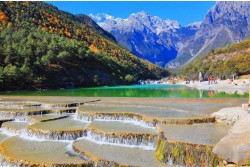You have no items in your shopping cart.


Introducing Lijiang Old Town
Lijiang Old Town, a well-preserved old city of minorities with brilliant culture, is a central town of the Lijiang. Located on the plateau 2,400 meters (7,874 feet) above the sea level, Lijiang Old Town looks like a big ink slab, therefore is named as the Town of Big Ink Slab (Dayanzhen). Lijiang Old Town which covers an area of 4 square kilometers was firstly built in the late Song Dynasty and the early Yuan Dynasty and has a history of more than 800 years. Since Kublai Khan set his reign here, Lijiang was on a fast developmental way and became the political, economic and cultural center in this area, playing a very important role in trades between Yunnan, China hinterland, Tibet, India and many other Asian countries.
Lijiang Old Town Fast Facts
• Chinese Name: Li Jiang Gu Cheng 丽江古城
• Best Time to Visit: All year around
• Recommended Visiting Hours: About 1 day
• Things to Do: Photography, Architecture, Bars, Art
• Opening Hours: All day
• Entrance Fee: CNY 50 for maintenance fee
• Address: Gucheng District, Lijiang, Yunnan
What to expect at Lijiang Old Town
Lijiang Old Town is the only old city built without walls. The reason goes that, Lijiang had been under the reign of the hereditary Mu family for more than 500 years; and if the Chinese character "Mu" (tree or wood) is put into a frame (walls), you have the character Kun which means siege or predicament in Chinese. This would mean that the governing Mu family and their descendants would always be trapped or in trouble.
As a result of the combination of the multinational culture and the progress of Naxi minority, the buildings in the Lijiang Old Town incorporate the best parts of the architectural traits of Han, Bai, and Tibet into a unique Naxi style. The layout of the town is free-style and flexible, the houses are close and diverse, and the lanes are narrow and crisscrossing. Most of Naxi houses are wood-tile structure compound with a garden. Naxi people pay much attention to the decoration too, most of their houses are engraved with vivid figures of people and animals on doors and windows.
The Black Dragon Pool (Heilongtan) is the major water source of the Lijiang Old Town and subdivides into many streams that can reach most of the families and streets in the Lijiang Old Town. Due to the reticular aqueducts, willow trees grow everywhere and there are almost 350 varied and inimitable bridges in the little town, some of which were built in the Ming and Qing Dynasties. The usage of the water created by the local people is very scientific, they build three mouths for every well from the upriver to the downriver; the water in the first mouth is for edibility, the second is for cleaning food, and the last one is for laundry. The water not only meets the need of the dwellers, but also gives the town a beauty; thus, the Lijiang Old Town is reputed as the Oriental Venice and Suzhou in Highland.
How to get to Lijiang Old Town
• Take local bus 2, 3, 4, 7, 10, 11, 14, 15, 16, 18, 19, 26, 27, 30, 31, 32, 107 or 209 and get off at Zhongyi Shichang Station.
• Lijiang Old Town is approximately 540km away from Kunming and 170km from Dali. Bullet trains from Kunming and common trains from Dali are available to Lijiang.
• Take a bus from Tourist Bus Station near the South Gate of Dali Ancient Town, Dali North Bus Station or Dali Express Bus Station to Lijiang Bus Station in Lijiang Old Town.
• Rent a car/bus from GGC to enjoy a hassle free private transfer from hotels in Lijiang, Kunming & Dali to Lijiang Old Town.
Additional travel advice on Lijiang Old Town
• Keep the entrance ticket (receipt of maintenance fee) along with you for ticket-checking at some attractions in the old town.
• Please take care of your belongings in the old town.
• Please wear sunscreen, hat and sunglasses to prevent sunburns.
• For the safety, it is not suggested to take a tricycle or other transportation without an operating license in the old town.